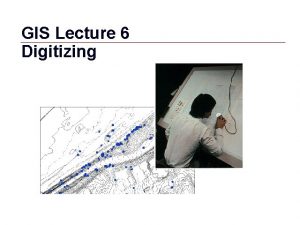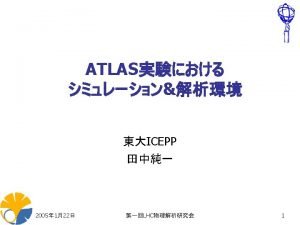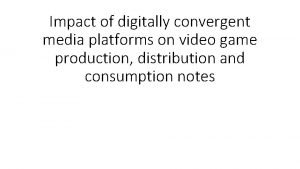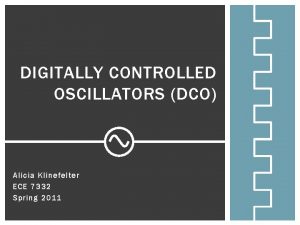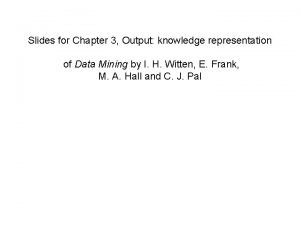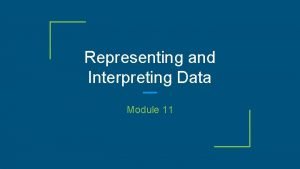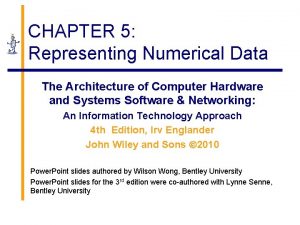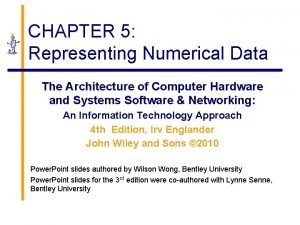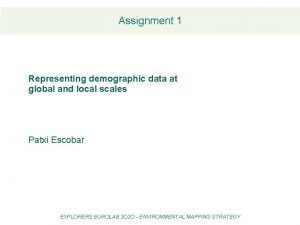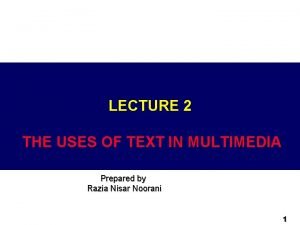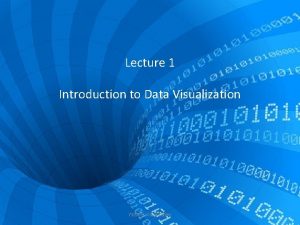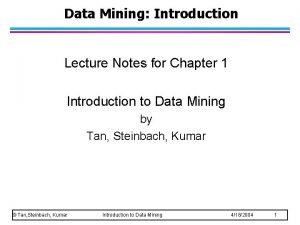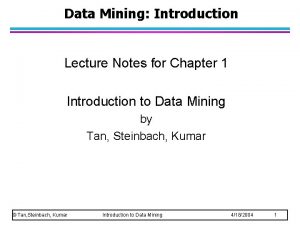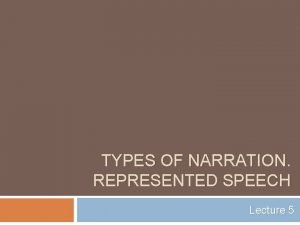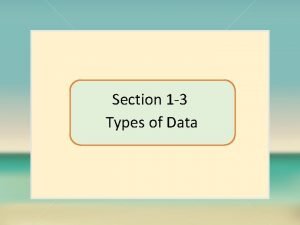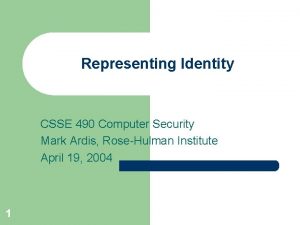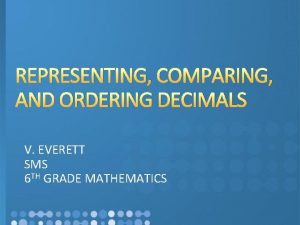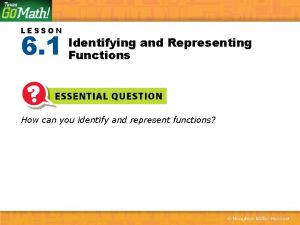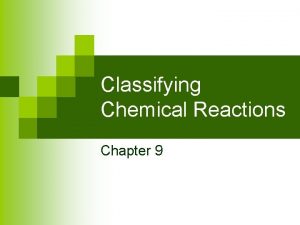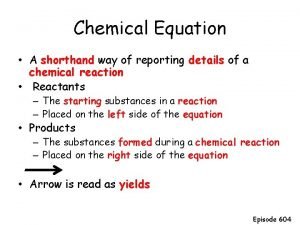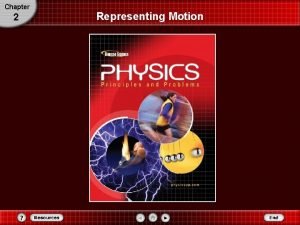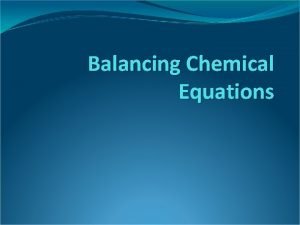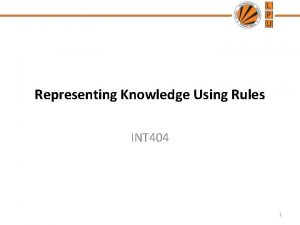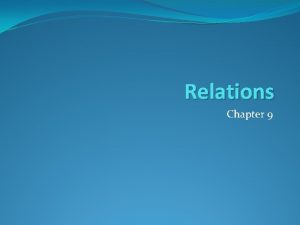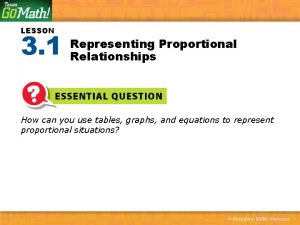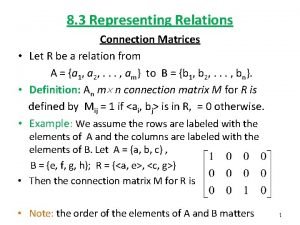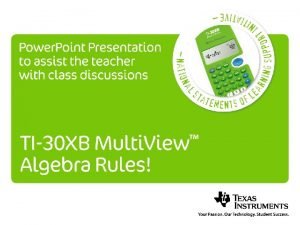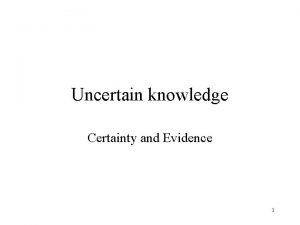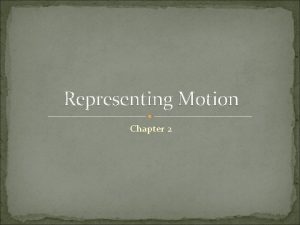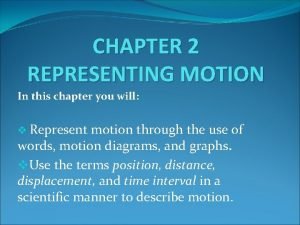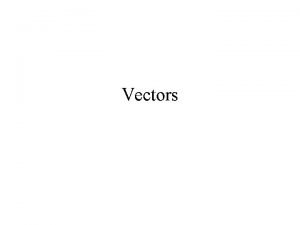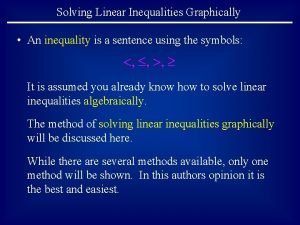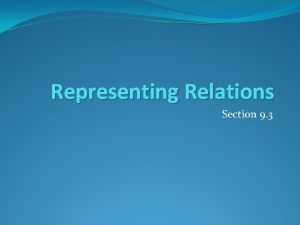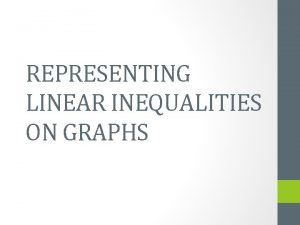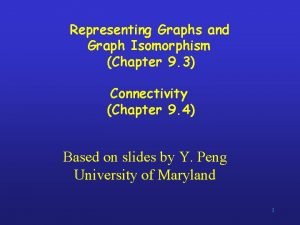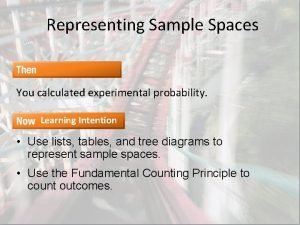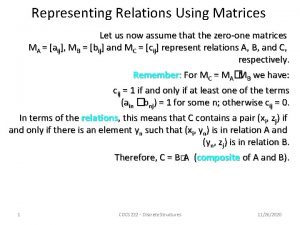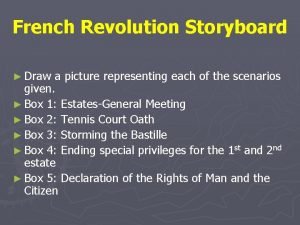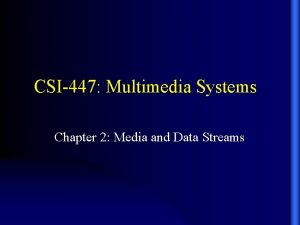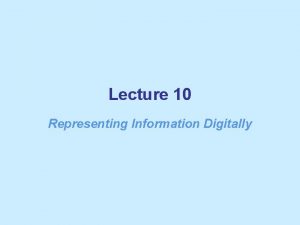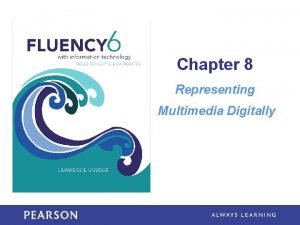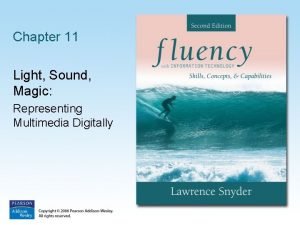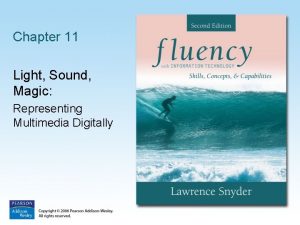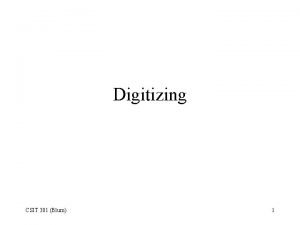Lecture 11 Representing Multimedia Digitally Digitizing Data Text



























































- Slides: 59

Lecture 11 Representing Multimedia Digitally

Digitizing Data • Text is easy • What about multimedia? – Photos, audio, and video • Same principles

Color and the Mystery of Light • Color image – Grid of pixels • Pixel is formed from three primary colors – RGB

Showing Colors • Colors formed by using 3 intensities of primaries – Full intensity red, green, or blue – Full intensity of red, green, and blue? – No intensity of any color? – Other combinations

LCD Display Technology • Close-up of white arrow pointer – Note subpixels

Black and White Colors • Intensity of light color stored in byte • Needs 3 bytes/pixel – Smallest intensity is 0000 • Decimal? – Largest value is 1111 • Decimal?

Black and White Colors • Black is absence of light: – 0000 0000 • White is full intensity of each color: – 1111 1111

Color Intensities • Consider blue (0000 • 8 bits have position values 1111) 128 64 32 16 8 4 2 1 1 1 1 1 • To cut intensity in half 128 64 32 16 8 4 2 1 1 0 0 0 0

Color Intensities

Decimal to Binary • How to convert decimal to binary? – Look for powers of 2 and subtract • E. g. : Convert 365 to binary

Lighten Up: Changing Color by Addition • What color does this represent? 1100 1000 • It’s RGB (200, 200), a grey – #C 8 C 8 in hex – All grays of form (x, x, x)

To Increase Intensity: Add in Binary • Increase common value to lighten – E. g. , add 0001 0000 (decimal 16) to each color 1101 1000 RGB (216, 216)

Lightening Adding another 16… 1101 1000 + 0001 0000 -------- Check using decimal!

Lighter Still: Adding with Carry Digits • Binary addition is similar to decimal addition – Work from right to left – 0 + 0 = 0, 0 + 1 = 1, 1 + 0 = 1 • No carry – 1 + 1 = 0 • Carry of 1

Binary Addition

Binary Addition

Binary Addition


Computing on Representations • Example: changing the brightness and contrast of a photo

Brightness and Contrast • Brightness – How close to white • Contrast – Difference b/w darkest and lightest portions of image • Photo manipulation software often gives values of pixels in a Levels graph

Levels Graph • 0 percent is black point (0, 0, 0) • 100 percent is white point (ff, ff) • Midpoint of pixel range is gamma point

Brightness • Shift pixels closer to white • Add 16 to each pixel • E. g. : (197, 197) => (213, 213)

Contrast • Scale pixel range – Stretch toward right • Add to each pixel, but – add a smaller amount for dark pixels – add a larger amount for light pixels

New Levels Graph

Adding Color • Color => (x, y, z), all 3 differ • Example – Colorize image of moon

Making the Moon Orange • Tint white regions – Pick a shade of orange, say (255, 213, 132) • Tint light gray – Red byte: leave unchanged – Green byte: reduce green slightly (subtract 42) – Blue byte: reduce blue significantly (subtract 123)


Digitizing Sound • Vibrating object creates sound • Vibrations “push” air to form pressure wave • Wave vibrates our eardrums

Digitizing Sound • Intensity of push determines volume • Frequency (# of waves per second) of pushes determines pitch continuous (analog) representation of the wave

Analog to Digital • Need to digitize to bits • Use binary # for amplitude of wave • At what point do you measure? – Infinitely many possible

Analog to Digital • Sample at regular intervals • Samples/second is sampling rate

Nyquist Rule for Sampling • Sampling rate is key • Nyquist rule – Sampling rate must 2 x highest frequency – Range of human hearing 20 Hz – 20 KHz • Digital audio sampling rate is 44. 1 KHz

Digitizing Process

Digitizing Process • Recording (digitizing) process – Sound => mic – Signal sampled by ADC • Samples encoded in binary

Digitizing Process • Playing process – Numbers read by DAC – Electrical wave created by interpolation – Electrical signal => speaker

How Many Bits per Sample? • Perfect accuracy requires unlimited bits/sample • Must handle both +/- values • More bits => more accuracy

How Many Bits per Sample? • More bits yields a more accurate digitization • Digital audio uses 16 bits

Advantages of Digital Sound • Key advantage is ability to compute on representation – Remove noise – Compression • Lossless • Lossy – Frequencies outside our range

Advantages of Digital Sound • MP 3 format – Allows for compression ratio > 10: 1 • Another key advantage of digital representations is exact reproduction

Digital Images and Video • Image is grid of RGB pixels • Stored as linear sequence • Can take up a lot of space

Digital Images and Video •

Image Compression • Typical monitor has fewer than 100 ppi – 9 x space saving over 300 ppi • Still requires more than 5. 5 min to send

Image Compression • Compression changes rep to use fewer bits – Example: faxes • Faxes are a sequences of 0’s and 1’s • Use run-length encoding

Compression • Run-length encoding is “lossless” • Opposite is “lossy compression”

Compression • MP-3 – Lossy scheme – Highs and lows lost • JPG (or JPEG) – Lossy scheme for images – Exploits limits of human perception • Luminance sensitivity • Chrominance insensitivity

JPEG Compression • JPEG is capable of 10: 1 compression w/o detectable loss of clarity

JPEG Compression • Ratios higher than 10: 1 – Smaller files – Possible artifacts (pixelation)

MPEG Compression • MPEG used for video • Video is sequence of stills – Each image/frame is not seen for long

MPEG Compression • JPEG used to compress frames • “Interframe coherency” is used – MPEG compression only transmits “deltas” b/w frames – Results in significant compression

Optical Character Recognition • OCR – Converts images of characters to characters – Used by U. S. P. S. – Used in banking – Used in automatic license-plate recognition

Virtual Reality • VR – Simulates real-world environment – Digitizes 3 D space, sound – Uses head-mounted displays – Training: surgeons, military

Haptic Devices • Haptic devices – Used in VR – Input/output technology for sense of touch – Gloves can apply forces

Latency • Challenges with VR – Latency • Time it takes for info to be recv’d – Bandwidth • Info per unit time – Fundamental limit: speed of light

Bits Are It! • 4 bytes can represent different info – Number – 4 characters – Color – etc. • Bias-Free Universal Medium Principle – Bits can represent all discrete info – Bits have no inherent meaning

Bits: Bias-Free • What does this bit sequence represent? 0000 1111 0000 1000 0010 0000 In hex: 00 F 1 08 20 • Depends on context

Bits are bits…

Summary • RGB color • Manipulating images • Binary numbers and arithmetic • Digitizing sound, images, video – Compression

Summary • OCR • Virtual Reality • Latency and Bandwidth • Bias-Free Universal Medium Principle

Quiz • How many colors can 9 bits represent? • 1010 + 0110 = ? • Convert C 7 to binary
 Heads down digitizing
Heads down digitizing Grappa
Grappa What is an example of a text-to-media connection?
What is an example of a text-to-media connection? What is digitally convergent media
What is digitally convergent media Digitally controlled oscillators
Digitally controlled oscillators 01:640:244 lecture notes - lecture 15: plat, idah, farad
01:640:244 lecture notes - lecture 15: plat, idah, farad Knowledge representation in data mining
Knowledge representation in data mining What kind of graph is this
What kind of graph is this Representing numerical data
Representing numerical data Representing numerical data
Representing numerical data Representing data assignment
Representing data assignment Multimedia becomes interactive multimedia when
Multimedia becomes interactive multimedia when What is the meaning of table of content
What is the meaning of table of content Csc 253
Csc 253 Esa multimedia.esa.int./multimedia/virtual-tour-iss
Esa multimedia.esa.int./multimedia/virtual-tour-iss In text citation for a lecture
In text citation for a lecture What are the types of text in multimedia
What are the types of text in multimedia Text in multimedia
Text in multimedia Exploratory data analysis lecture notes
Exploratory data analysis lecture notes Bayesian classification in data mining lecture notes
Bayesian classification in data mining lecture notes Data mining lecture notes
Data mining lecture notes Data visualization lecture
Data visualization lecture Data mining lecture notes
Data mining lecture notes Data mining lecture notes
Data mining lecture notes Types of narration
Types of narration It consists of numbers representing counts or measurements
It consists of numbers representing counts or measurements Representing identity in information security
Representing identity in information security Representing comparing and ordering decimals
Representing comparing and ordering decimals Draw vector arrows representing the vx and vy brainly
Draw vector arrows representing the vx and vy brainly Nejime floral
Nejime floral Identifying and representing functions lesson 6-1
Identifying and representing functions lesson 6-1 Chaos symbolism
Chaos symbolism A chemist shorthand way of representing chemical reaction
A chemist shorthand way of representing chemical reaction A chemist shorthand way
A chemist shorthand way Representing motion
Representing motion Shorthand way of describing a reaction
Shorthand way of describing a reaction Representing knowledge using rules
Representing knowledge using rules Representing relations using digraphs
Representing relations using digraphs Representing proportional relationships
Representing proportional relationships Representing relations using digraphs
Representing relations using digraphs Function can be represented
Function can be represented Representing knowledge in an uncertain domain
Representing knowledge in an uncertain domain Picturing motion physics
Picturing motion physics Meaning:representation
Meaning:representation Chapter 2 assessment physics
Chapter 2 assessment physics Rikkwa
Rikkwa What is the purpose of drawing a motion diagram
What is the purpose of drawing a motion diagram A vector is a quantity that has
A vector is a quantity that has How to solve an inequality graphically
How to solve an inequality graphically Representing relations using matrices
Representing relations using matrices Represent linear inequalities
Represent linear inequalities Representing graphs and graph isomorphism
Representing graphs and graph isomorphism Representing graphs and graph isomorphism
Representing graphs and graph isomorphism Representing vectors
Representing vectors Representing sample spaces
Representing sample spaces Representing relations using digraphs
Representing relations using digraphs Given the balanced equation representing a reaction
Given the balanced equation representing a reaction Army storyboard example
Army storyboard example Don tiburcio
Don tiburcio Data stream characteristics for continuous media
Data stream characteristics for continuous media
